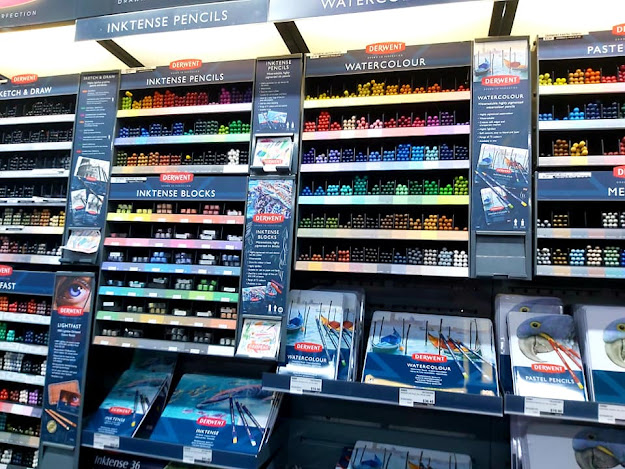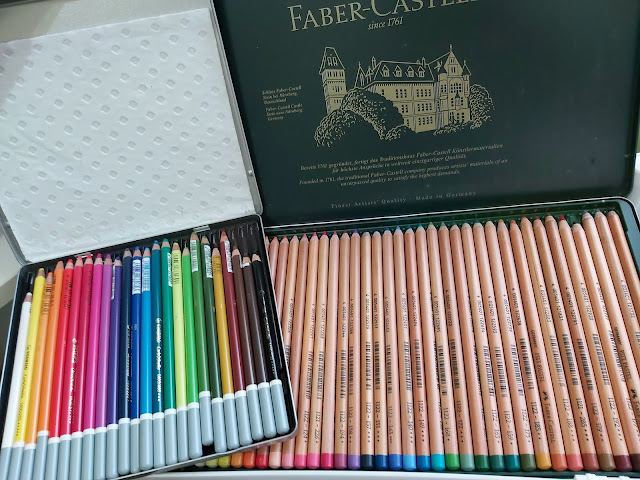Derwent coloured pencils: Coloursoft, Lightfast, Artist, Drawing, what's the difference among the different ranges?
When I first entered the foray of coloured pencils in June 2020, I was expecting to find different types, but I sure wasn't expecting the overwhelming variety. As I did my research, my head swam from the number of brands and types.
And then I discovered Derwent. I bought a few single coloured pencils to try and loved the quality, so I was quickly hooked. But just the one brand Derwent alone has so many ranges of coloured pencils that it's enough to paralyse the newbie just from sheer choice. What's the difference? Which one suits me better? Why is one more expensive than another?
So I thought I would write a post breaking down the different ranges of Derwent coloured pencils. I'm not sponsored by Derwent (I wish!) Just helping out fellow coloured pencil artists here.
Derwent Artists
Derwent Artists Pencils were the first and oldest coloured pencils put out by Derwent in 1938. These were created for professional artists and for a long time, was the only professional set by Derwent. Coloured pencil as an art medium was only taken seriously more recently, so there weren't that many choices in the past.
I don't have any Derwent Artists pencils but from online reviews, it's a harder pencil that allows for many layers and fine details. It has the largest range of 120 colours.
Derwent Studio
Derwent Studio Pencils are in actuality just an adaptation of Derwent Artists pencils. Instead of a round barrel, it's hexagonal. The colour range is exactly the same as Derwent Artists. I don't have any Derwent Studio pencils either, so I can't comment.
Derwent Coloursoft
When Derwent came out with the Coloursoft range, a lot of artists went crazy for it. It's touted as the softest coloured pencil around, with creamy colour that's great for blending. If you like buttery smooth coloured pencils where you don't have to apply a lot of pressure for pigment payoff, you might like these. There are 72 colours altogether.
I have one Coloursoft pencil and here's what I think: I dislike it. It's very soft but to the extent where it feels more like a crayon. It's very waxy and while yes, it's smooth as butter and glides on the paper easily, the effect is very fuzzy. You get a somewhat painterly, pastelly look, which is not bad in itself if that's what you like, but if I wanted that look, I would just go with my pastels.
And because it's so soft, it breaks easily and you absolutely cannot get fine details with this pencil. I'm glad I only bought one pencil, I don't intend to get any more.
Derwent Drawing
The Derwent Drawing pencils are a speciality range meant to supplement other coloured pencil sets. The limited range of only 24 colours is created for nature artists - all the hues are earthy tones of mostly muted browns, greens and blues. The formula is soft and creamy.
The is a thicker pencil, which gives it a substantial grip. I bought a few loose Drawing pencils and I love them. They're buttery soft like Coloursoft but don't give a crayon-y look. The colours are perfect for me since I draw animals. I can find muted shades of browns for fur that are hard to come by in other coloured pencil ranges.
The Derwent Drawing Chinese White pencil is also somewhat legendary as being one of the whitest white coloured pencils there is.
Derwent Procolour
According to the Derwent website, Procolour combines the hardness of the Artists pencils with the strong pigment of Coloursoft to give artists a good balance of colour with fine details. I'm guessing Procolour was created as a second generation of professional grade coloured pencils after the Artists range, to cater to a growing market. There are 72 colours in this range.
I bought one Procolour pencil to try and this is the only Derwent coloured pencil that I dislike with every fibre of my being. I don't know if it's just the colour I bought (Sky Blue) but gosh, it's so hard that I feel like I need to have the muscles of an arm wrestler just to use this pencil. It's even harder than the Faber-Castell Polychromos, which I wouldn't have thought possible. And after all that effort, the colour payoff is uneven and hard to blend. It's relatively expensive too. This is just my opinion, of course, but there is simply no redeeming quality about this pencil in my mind.
Lightfast
And then we come to the Lightfast. Launched only in 2018, the Lightfast range completely changed the coloured pencil game, in my opinion. It's the only Derwent oil-based coloured pencil, and while most oil-based pencils are harder, Derwent managed to create one that's soft and a joy to use, yet layers extemely well. I think it performs way better than the much touted Faber-Castell Polychromos (full review and comparison here).
It has 100 colours and if you want a professional set from Derwent, I'd say ditch the Procolour and go for the Lightfast. It wins hands down.
Watercolour
As its name suggests, the Derwent Watercolour pencils are water-soluble pencils. These are nice if you like to add water to give your drawings a watercolour effect. These are soft and creamy, like most water-soluble pencils.
I've done a review of it here. There are 72 shades in all.
Inktense
The Inktense range is another water-soluble coloured pencil. It's essentially ink in a stick (there's also Inktense blocks which are literally sticks of pigment). Add water and you get pure ink pigment. There are 72 colours in the range.
I won't go into detail because I've already done a separate review of it.
Metallic
Derwent Metallic pencils are quite interesting - these are not just in traditional metal colours like copper, gold and bronze, but also in hues like green, blue and purple. The new 20th anniversary set was just launched with 20 colours, supposedly featuring an improved formula and lightfast ratings.
I don't have any in this range. With most metallic pencils, I don't think you can expect a super shiny effect, even on black paper where it's supposed to work better. I have metallic pencils from another brand and they give a nice sheen but you won't get the same metallic effect that you can get with say, markers. Online reviews mostly say they're nice to use. It's a fun extra, I guess, but not really necessary.
Academy
Finally, we have the Derwent Academy, which is the student-grade coloured pencils of the brand. They're significantly cheaper than the artist-grade coloured pencils, so are great for students or kids. I haven't tried these but online reviews are generally quite positive, especially considering the price point.
Others
There are a couple of other ranges of Derwent pencils, namely the pastel pencils and the tinted charcoal pencils. However, since these are not technically what I would consider as "coloured pencils", I won't include them here. I may talk about them in another post.
Cost
I tried compiling a list for easy comparison of the different ranges based on Art Friend's prices (as at October 2020) as they have the best prices for Derwent. However, I know for a fact that some of the prices listed on their website are not updated, as I've spotted discrepencies in the actual shop. I've listed the prices of the products I know first hand from buying them, and the others taken from their website are marked with an asterix, meaning they might be slightly off.
Range Single 12-set 24-set
Artists S$2.00 S$18.60 * S$35.93 *
Studio S$1.80 S$18.90 S$36.45
Coloursoft S$1.90 S$19.90 S$38.45
Drawing S$2.25 S$22.90 S$44.90
Procolour S$2.10 S$21.90 S$42.90
Lightfast S$2.60 S$28.90 S$54.90
Watercolour S$1.80 S$19.95 S$36.45
Inktense S$2.10 S$20.90 S$41.45
Metallic S$2.20 not found not found
Academy not available S$8.24 S$16.48
I've found Derwent to be an excellent brand of coloured pencils. Whether you're just starting out or moving into coloured pencils more seriously, they're worth considering. I hope this post helps sort out the confusion you might have over the different ranges.
Happy colouring!













Comments
Post a Comment